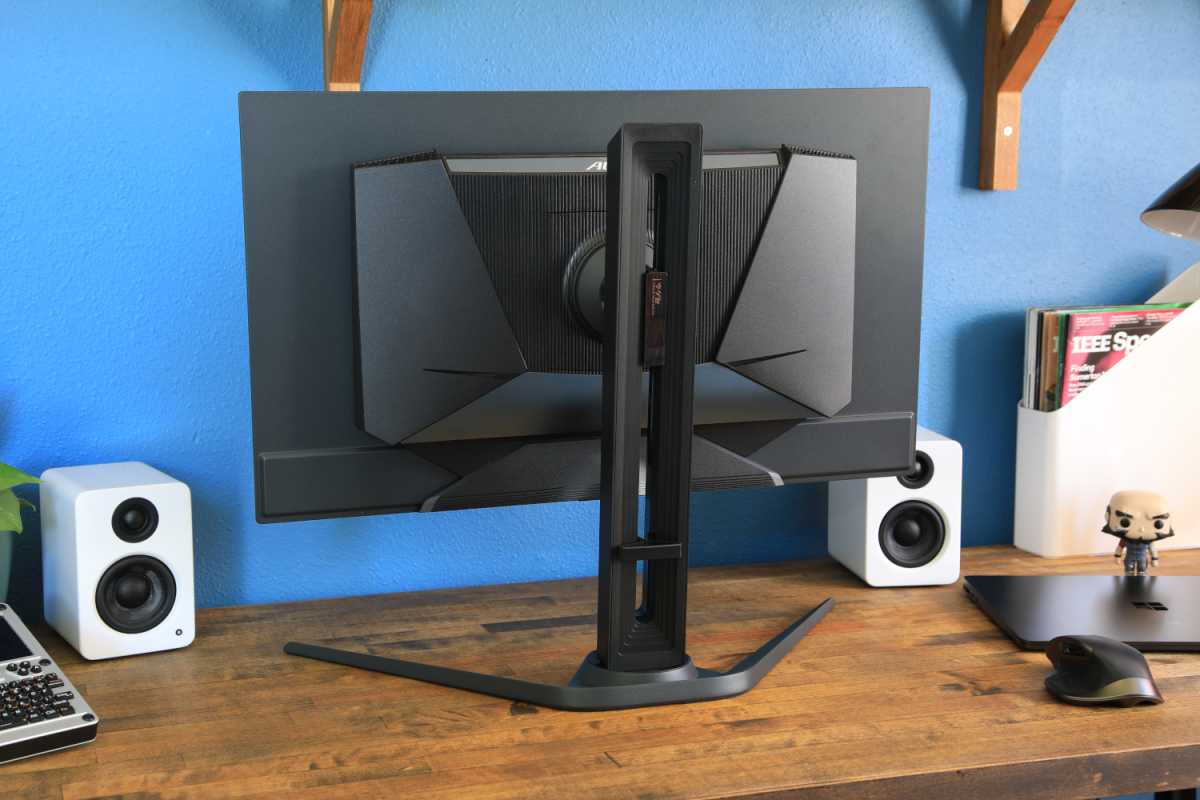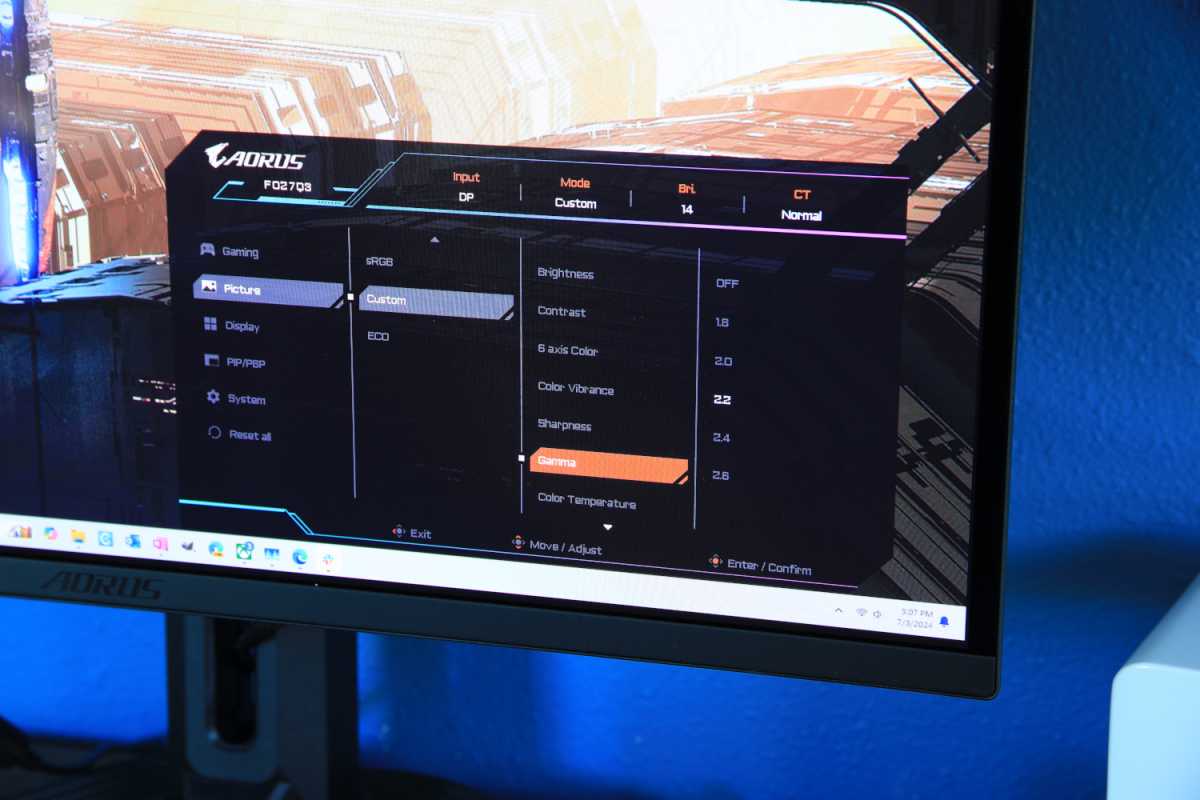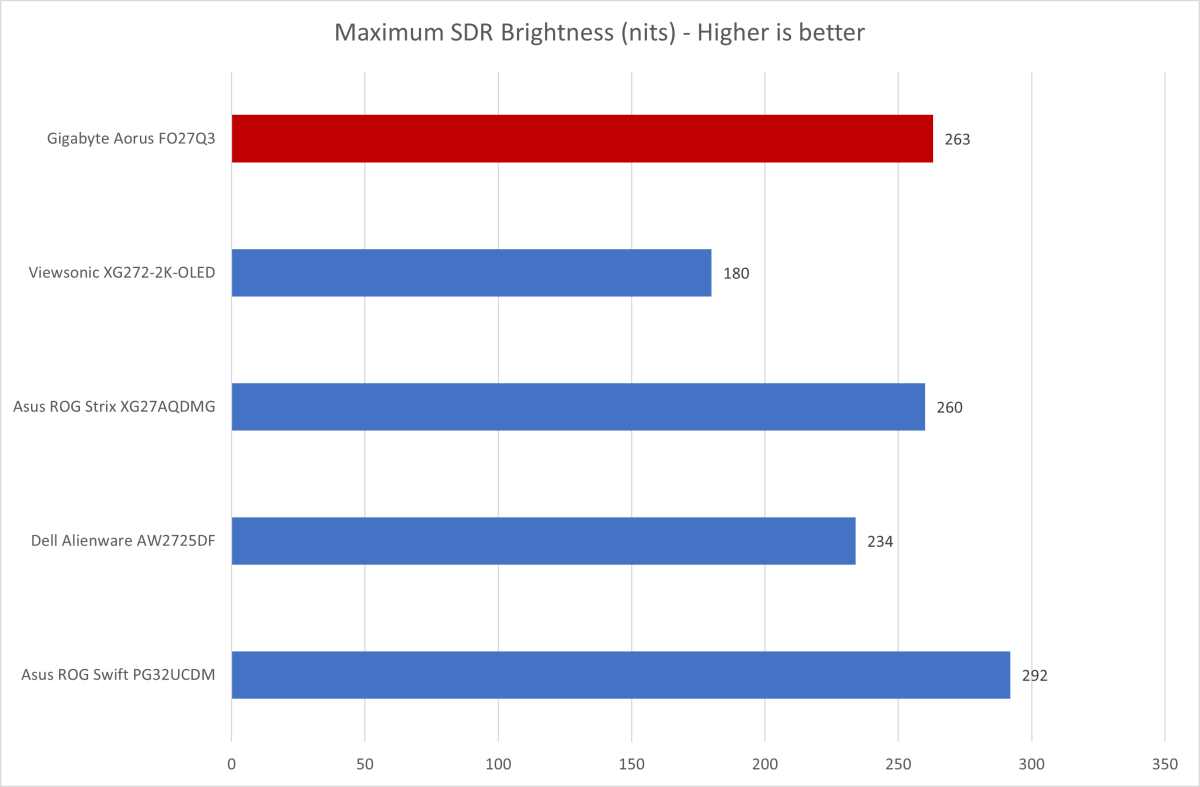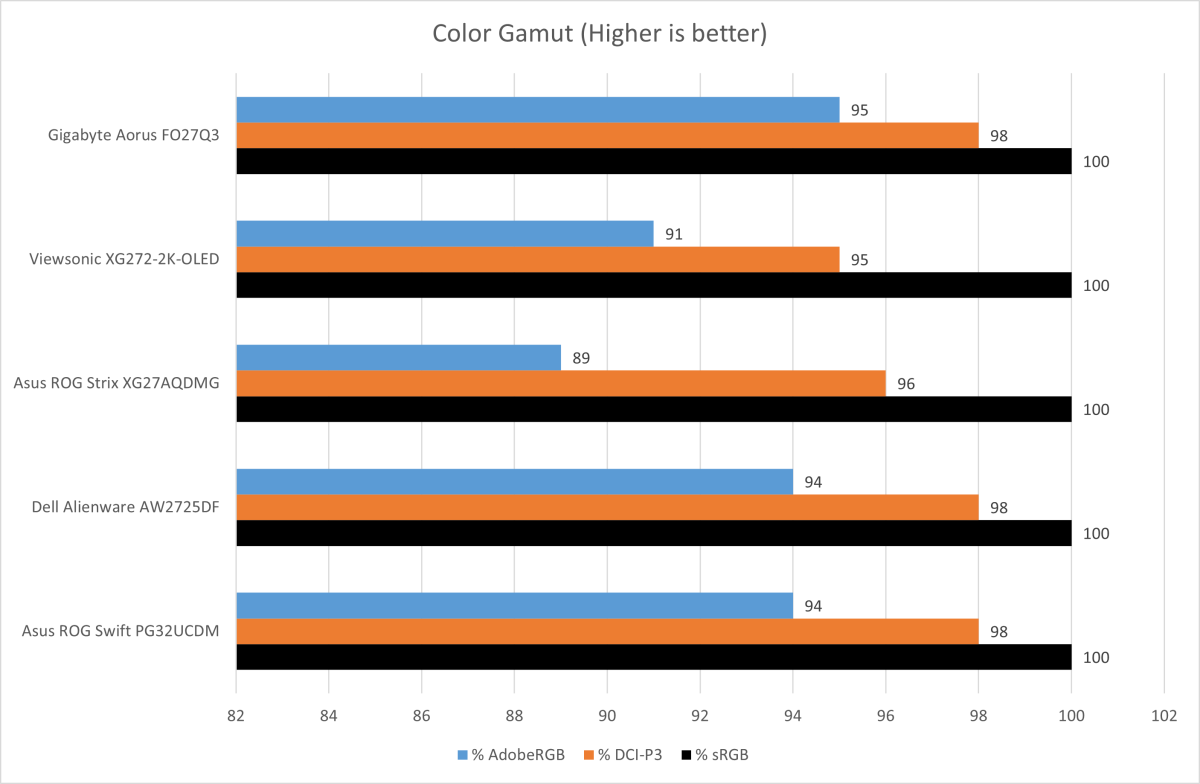
 Image: Matthew Smith / Foundry
Image: Matthew Smith / Foundry
At a glance
Expert’s Rating
Pros
Excellent SDR image qualitySuperb motion clarityFour video inputs including one USB-CGood range of image-quality controls
Cons
Several small design problemsMediocre HDR performanceSome OLED competitors are less expensive
Our Verdict
The Gigabyte Aorus FO27Q3 has a gorgeous QD-OLED panel and plenty of connectivity, though tight competition makes it hard for the monitor to stand out.
Price When Reviewed
799.99
Best Prices Today: Gigabyte Aorus FO27Q3
RetailerPriceB & H Photo$799.99View Deal $799.99View DealPrice comparison from over 24,000 stores worldwideProductPricePrice comparison from Backmarket
$799.99View DealPrice comparison from over 24,000 stores worldwideProductPricePrice comparison from Backmarket
It’s another week and another new monitor, this time from Gigabyte. The Aorus FO27Q3 is a 27-inch QD-OLED monitor that targets gamers but might have broader appeal to content creators and for general use. It is not the least expensive monitor in its category, but also not the most, and offers solid connectivity alongside good picture quality. Gamers who want USB-C should pay particular attention.
Gigabyte Aorus FO27Q3 specifications
The Gigabyte Aorus FO27Q3’s panel is similar to most of its competitors. It’s a QD-OLED panel from Samsung with a display size of 26.5 inches, a native resolution of 2560×1440 pixels, and a maximum refresh rate of up to 360Hz.
Display size: 26.5-inch 16:9 widescreenNative resolution: 2560×1440Panel type: QD-OLEDRefresh rate: Up to 360HzAdaptive sync: Adaptive Sync, AMD FreeSync Premium ProPorts: 2x HDMI 2.1, 1x DisplayPort 1.4, 1x USB-C upstream with DisplayPort Alternate Mode and 18 watts of Power Delivery, 1x USB-B upstream, 2x USB-A 3.2, 1x headphone jack, 1x microphone jackVESA mount: 100x100mmSpeakers: 2x 5-watt speakersPrice: $799.99 MSRP
The monitor includes a lot of connectivity with a total of four video inputs, one of which is a USB-C port. The monitor also has a pair of 5W speakers, which is a feature some gaming monitors omit.
Further reading: See our roundup of the best gaming monitors to learn about competing products.
Gigabyte Aorus FO27Q3 design
The Gigabyte Aorus FO27Q3 looks good out of the box, but some details hold up better than others. The monitor uses glossy accents to provide a touch of class and luxury to the display, and they do the job. The monitor clearly looks like a gaming monitor, but it’s not garish or gaudy.
However, some of the plastic, especially on the stand base and around the edges of the rear panel, looks a bit cheaper than I would like. It has RGB-LED ambient lighting on the rear of the display panel, but it’s extremely dim and allows only limited customization, which might disappoint gamers wanting their monitor to add flair in the dark.

Matthew Smith / Foundry
Matthew Smith / Foundry
Matthew Smith / Foundry
I also noticed two design oddities. First, the display panel’s viewable area wasn’t centered in the monitor’s viewable area. Instead it’s slightly up and to the right, with a visible gap between the true bezel and where the viewable area begins. I didn’t even notice it for several days, but once I did, it was hard not to see it. Also, the cable routing hole in the stand is too small to accommodate the power cord, so you’ll have to settle for the power cord dangling across your desk.
The monitor ships with an ergonomic stand that provides adjustment for height, tilt, swivel, and pivots 90 degrees for use in landscape orientation. The stand is sturdy but has a wide base that takes up a little more room than some competing monitors. With that said, the base isn’t overly thick or tall, so the space it consumes on your desk is mostly usable. A 100x100mm VESA mount is included on the back of the display panel, making it easy to attach a third-party monitor arm or stand.
Gigabyte Aorus FO27Q3 connectivity and menus
Gigabyte packs a lot of connectivity into the FO27Q3. The monitor has two HDMI 2.1 ports and one DisplayPort 1.4 port, which can handle the monitor’s maximum refresh rate and resolution. It also has a USB-C port with DisplayPort Alternate Mode. The USB-C port includes power delivery but only provides up to 18 watts, so it’s not useful for charging a connected laptop.
The monitor also has two USB-A 3.2 downstream ports for connecting wired peripherals. These can be driven by the USB-C port or a USB-B port also found on the back of the monitor, which makes the monitor a USB hub, although two ports are nothing to get excited about. It includes two audio jacks, one for headphones and one for a microphone, which could be useful if you have a dedicated microphone.
You’ll access the on-screen menus through a joystick that is centered on the back of the lower display bezel. It is responsive and easy to use, as is true of most such controls found on monitors, and Gigabyte’s monitor options are sensibly laid out. The font size for some options is a bit small, and can be more difficult to read than is ideal.

Matthew Smith / Foundry
Matthew Smith / Foundry
Matthew Smith / Foundry
Many image quality options are available, including six-axis color customization, a number of gamma presets that target precise gamma values, and several color temperature presets. The color temperature presets are vague, however, labeled as “warm” or “cool” rather than a specific color temperature value. Still, this is a good range of quality customization for a monitor and will help people dial in the image to their preference.
The monitor includes a typical suite of gaming-centric features like a timer, crosshairs, and picture-in-picture/picture-by-picture modes. There’s a black equalizer to elevate the brightness of games and a night vision mode meant to reveal detail specifically in dark scenes. The monitor can also restrict the visible area to 24 inches at a resolution of 1080p, which might be helpful if you want to squeeze out maximum frames per second in a highly competitive game. These features are useful, but also found in Gigabyte’s competitors.
A pair of 5-watt speakers round out the monitor’s features. They provide okay volume but otherwise are nothing special. They’re usable if you just want to listen to a podcast or have a bit of music at low volume in the background, but they’re not going to be adequate for enjoying PC games.
The Gigabyte has an especially saturated and colorful image that looks great in movies and games.
Gigabyte Aorus FO27Q3 SDR image quality
Spoiler alert: The QD-OLED panel in the Gigabyte Aorus FO27Q3 looks very similar to QD-OLED panels in other 27-inch OLED monitors released in 2024. With that said, the FO27Q3 performs well against its peers.

Matthew Smith / Foundry
Matthew Smith / Foundry
Matthew Smith / Foundry
The Gigabyte delivered a maximum SDR brightness of 263 nits, which is typical for an OLED monitor of any size and with any panel type. This is fine for most situations, but it could look a bit dim if you intend to use the monitor in a room with many bright sunlit windows or with a lot of overhead lighting. Of course, since other OLED monitors don’t get much brighter in SDR, this is a common limitation. It’s a glossy panel, too, so reflections can be an issue.

Matthew Smith / Foundry
Matthew Smith / Foundry
Matthew Smith / Foundry
Contrast is a strength of all OLED monitors, and the Gigabyte is no different. It is capable of achieving a minimum luminance of zero nits, which is perfect, and because of that, it has an effectively infinite contrast ratio. This leads to an immersive image with an excellent sense of depth and realism. It performs especially well in darker scenes or when viewing the display in a dark room, as the OLED display can reveal significant shadow detail that an IPS or VA panel display with an LED backlight would miss.
However, this is true of all similar OLED monitors, so Gigabyte has no advantage or disadvantage here.

Matthew Smith / Foundry
Matthew Smith / Foundry
Matthew Smith / Foundry
Color gamut is where we start to see separation between OLED monitors. The Gigabyte has a Samsung QD-OLED panel, as is also true of the Asus ROG Swift PG32UCDM and Alienware AW2725DF. These monitors offer an extremely wide color gamut that covers up to 98 percent of DCI-P3 and 95 percent of Adobe RGB. Monitors using an LG WOLED panel, like the ViewSonic Elite XG272-2K-OLED and Asus ROG Strix XG27AQDMG, are at a slight disadvantage with color gamuts that tend to reach 95 percent of DCI-P3.
The Gigabyte has an especially saturated and colorful image that looks great in movies and games. It can also be useful for photographers, videographers, and digital artists who want to ensure they can view close to the full range of color present in their content.

Matthew Smith / Foundry
Matthew Smith / Foundry
Matthew Smith / Foundry
It’s a similar story in color accuracy. Here again, the QD-OLED monitors, including the Gigabyte, outperform the WOLED monitors. All the monitors listed here have good color accuracy on the whole and will look realistic out of the box, but it is clear that QD-OLED has the edge. The Gigabyte does perform worse than the other QD-OLED monitors we have tested, though.
Gigabyte posts respectable gamma and color temperature results. The default gamma curve came in at 2.3, which is slightly off the target of 2.2 and means that the image looks a bit dimmer and darker than ideal out of the box. The default color temperature, meanwhile, came in at 6300K, which is a bit warmer than our target of 6500K. These variances are tight enough that I doubt most people would immediately notice them, and other OLED monitors are similarly off-target at their default settings (though some, like the Viewsonic XG272-2K-OLED, are instead too bright and cool).
Sharpness can be an issue for QD-OLED monitors due to the specifics of the subpixel structure, which can cause small fonts and high-contrast edges to look more pixelated than you would expect for a 1440p monitor. This issue is visible on the Gigabyte, but it is usually not overly distracting. It tends to show up far more often in Microsoft Excel than in PC games, so it’s more of a concern for productivity than entertainment. With that said, gamers who want excellent sharpness in an OLED should consider a 32-inch 4K panel (unfortunately, 27-inch 4K OLED panels are not yet available).
The Gigabyte’s overall SDR image quality is strong. Like other QD-OLED monitors, the Gigabyte scored well in contrast and color gamut tests. Maximum SDR Brightness is a bit lower than I would like to see, but the same is true for other OLEDs, and it’s still bright enough for most rooms. It’s a great display for SDR gaming that can handle dark, gritty games and cheerful, colorful games with equal ease.
Gigabyte Aorus FO27Q3 HDR image quality
The Gigabyte FO27Q3 is VESA DisplayHDR True Black 400 certified. That same level of certification is provided to most of the 27-inch monitors on the market today, indicating passable HDR performance, but the monitor’s brightness is usually not high enough to deliver the ideal experience.
The default HDR mode measured a maximum brightness of 362 nits in a 10 percent window, meaning that 10 percent of the screen was lit. Sustained full-screen brightness was no different than in SDR. These are not impressive results but fairly typical for a 27-inch QD-OLED monitor. Monitors with LG’s newest WOLED panel, like the Asus ROG Strix XG27AQDMG, tend to be brighter in highlights and a better choice for HDR content.
I tried other HDR modes and found that HDR Vivid mode could hit a sustained HDR brightness of 805 nits in a 10 percent window, which is extremely high for an OLED monitor. However, while it was bright, it didn’t necessarily show more detail in bright areas of the screen, and the mode had serious color accuracy issues. I wouldn’t recommend it for games or movies.
Gigabyte unlocks image quality controls in several HDR modes. That’s not true of many monitors that support HDR, although some OLED alternatives offer the same functionality. Messing with the image quality settings can lead to a technically less accurate presentation, but it’s often helpful on a monitor where you may need to tailor the brightness or contrast settings to fit the specific situation in which you’re using it and the content that you’re viewing.
Gigabyte Aorus FO27Q3 motion performance
Motion clarity is a strength for the Gigabyte Aorus FO27Q3. It has a maximum refresh rate of 360Hz along with a pixel response time of 0.03 milliseconds. Together, these numbers mean that the display shows very little ghosting behind fast-moving objects and feels responsive when playing fast-paced games at high frame rates. Motion clarity is better than an IPS or VA panel monitor with a 360Hz refresh rate because OLED has faster pixel response times than those alternatives.
Games also look fluid and stable thanks to the inclusion of AMD FreeSync Premium Pro and support for Adaptive Sync. Nvidia G-Sync compatibility is not part of the monitor’s feature set, but it should work since G-Sync is compatible with Adaptive Sync.
It would’ve been nice to see Gigabyte obtain official G-Sync certification, though, as competitors like Asus ROG Strix XG27AQDMG take that extra step. On the other hand, the Asus monitor has a maximum refresh rate of 240Hz. That’s enough for most games, but highly competitive players will prefer the Gigabyte’s higher refresh rate.
Should you buy the Gigabyte Aorus FO27Q3?
The Gigabyte Aorus FO27Q3 is yet another strong OLED monitor with a vibrant and colorful QD-OLED panel. The monitor has an infinite contrast ratio, good color accuracy, and excellent motion clarity thanks to a 360Hz refresh rate. All this adds up to a monitor that looks good straight out of the box and is well-suited for playing PC games.
Pricing and availability are obstacles. QD-OLED monitors seem to be having stock issues this summer, and the Gigabyte is out of stock at many retailers and has yet to receive significant price cuts. That makes it hard to recommend over a competitor like the Asus ROG Strix XG27AQDMG, which is currently more widely available at lower prices.
The Gigabyte is a good pick if you find it on sale for closer to $750, and its broad range of connectivity, including USB-C, can give it an edge if you intend to connect a lot of video inputs or peripherals to your monitor.
Best Prices Today: Gigabyte Aorus FO27Q3
RetailerPriceB & H Photo$799.99View Deal $799.99View DealPrice comparison from over 24,000 stores worldwideProductPricePrice comparison from Backmarket
$799.99View DealPrice comparison from over 24,000 stores worldwideProductPricePrice comparison from Backmarket
Author: Matthew S. Smith
Matthew S. Smith is a freelance technology journalist with 15 years of experience reviewing consumer electronics. In addition to PCWorld, his work can be found on Wired, Ars Technica, Digital Trends, Reviewed, IGN, and Lifewire. Matthew also covers AI and the metaverse for IEEE Spectrum and runs Computer Gaming Yesterday, a YouTube channel devoted to PC gaming history.
Recent stories by Matthew S. Smith:
Best monitor arms 2024: The ultimate in flexibilityBest 4K monitors 2024: HDR, 144Hz, budget, and best overallBest portable monitors 2024: Displays that go with you




